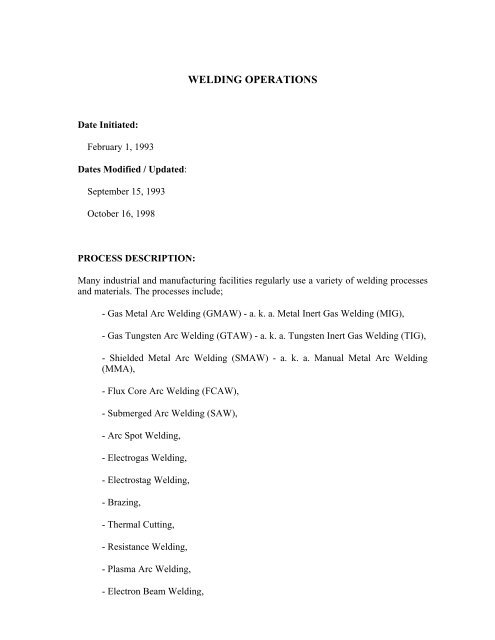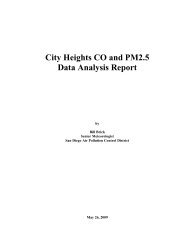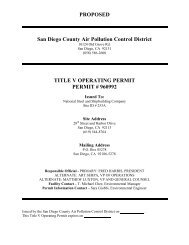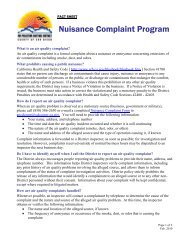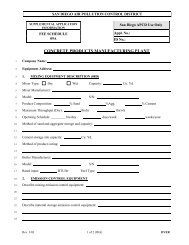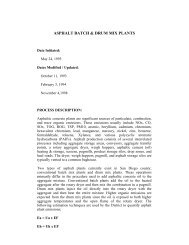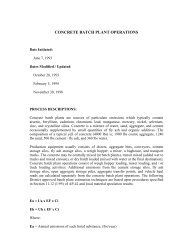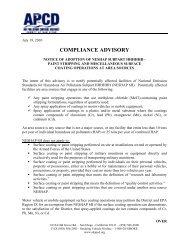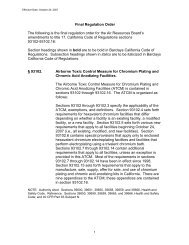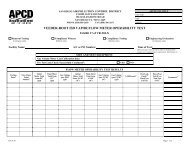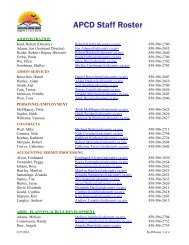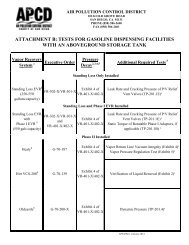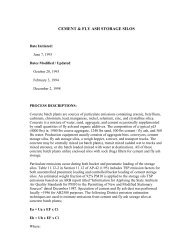WELDING OPERATIONS - Air Pollution Control District
WELDING OPERATIONS - Air Pollution Control District
WELDING OPERATIONS - Air Pollution Control District
Create successful ePaper yourself
Turn your PDF publications into a flip-book with our unique Google optimized e-Paper software.
<strong>WELDING</strong> <strong>OPERATIONS</strong>Date Initiated:February 1, 1993Dates Modified / Updated:September 15, 1993October 16, 1998PROCESS DESCRIPTION:Many industrial and manufacturing facilities regularly use a variety of welding processesand materials. The processes include;- Gas Metal Arc Welding (GMAW) - a. k. a. Metal Inert Gas Welding (MIG),- Gas Tungsten Arc Welding (GTAW) - a. k. a. Tungsten Inert Gas Welding (TIG),- Shielded Metal Arc Welding (SMAW) - a. k. a. Manual Metal Arc Welding(MMA),- Flux Core Arc Welding (FCAW),- Submerged Arc Welding (SAW),- Arc Spot Welding,- Electrogas Welding,- Electrostag Welding,- Brazing,- Thermal Cutting,- Resistance Welding,- Plasma Arc Welding,- Electron Beam Welding,
Uh = Maximum hourly usage of each welding rod, (lbs/hour)EF = Listed substance emission factor from AP-42, (lbs listed substance/lb rodconsumed)e = <strong>Control</strong> equipment PM10 collection and removal efficiency, (%)2) Where incomplete AP-42 (Section 12.9) information exists: If an emissionfactor is listed in AP-42 for the welding rod (w/ correct welding process) fumegeneration rate but not for the trace metal component, the following procedure willbe used;Ea = Ua x EF x FCF x Ci x (1 - e)Eh = Uh x EF x FCF x Ci x (1 - e)Where:Ea = Annual emissions of each listed toxic air contaminant per device, (lbs/year)Eh = Maximum hourly emissions of each listed toxic air contaminant per device,(lbs/hour)Ua = Annual usage of each welding rod, (lbs/year)Uh = Maximum hourly usage of each welding rod, (lbs/hour)EF = Particulate (PM10) emission factor from AP-42, (lbs fume/lb rod consumed)FCF = Fume correction factor per NASSCO - Richard Bell, (lbs metal/lb fume)= 0.5464 for GMAW= 0.2865 for SMAWCi = Concentration of listed substance in each welding rod, (lbs substance/lb metal)e = <strong>Control</strong> equipment PM10 collection and removal efficiency, (%)* If a hexavalent chromium emission factor does not exist, A Cr toCr+6 conversion rate of 5% for GMAW and 63% for SMAW will beapplied per ARB - Richard Bode. It is assumed that MIG and TIGwelding are similar to GMAW. It is also assumed that FCAW issimilar to SMAW.
3) Where no AP-42 information exists but the welding process is identified: Ifno emission information is listed in AP-42 but the type of welding process isidentified by the site (i.e.; GMAW, SMAW, etc.), the following procedure will beused;Ea = Ua x EF x FCF x Ci x (1 - e)Eh = Uh x EF x FCF x Ci x (1 - e)Ea = Annual emissions of each listed toxic air contaminant per device, (lbs/year)Eh = Maximum hourly emissions of each listed toxic air contaminant per device,(lbs/hour)Ua = Annual usage of each welding rod, (lbs/year)Uh = Maximum hourly usage of each welding rod, (lbs/hour)EF = Fume emission factor per ARB - Richard Bode, (lbs fume/lb rod consumed)= 0.01 for GMAW= 0.02 for SMAWFCF = Fume correction factor per NASSCO - Richard Bell, (lbs metal/lb fume)= 0.5464 for GMAW= 0.2865 for SMAWCi = Concentration of listed substance in each welding rod, (lbs substance/lb metal)e = <strong>Control</strong> equipment PM10 collection and removal efficiency, (%)** A Cr to Cr+6 conversion rate of 10% will be assumed by the<strong>District</strong> for unidentified welding processes.4) Where no AP-42 information exists and the welding process is unidentified:If no emission information is listed in AP-42 and the type of welding process is notidentified by the site (i.e.; GMAW, SMAW, etc.), the following procedure will beused;
Ea = Ua x EF x Ci x (1 - e)Eh = Uh x EF x Ci x (1 - e)Ea = Annual emissions of each listed toxic air contaminant per device, (lbs/year)Eh = Maximum hourly emissions of each listed toxic air contaminant per device,(lbs/hour)Ua = Annual usage of each welding rod, (lbs/year)Uh = Maximum hourly usage of each welding rod, (lbs/hour)EF = Fume emission factor, (lbs fume/lb rod consumed)= 0.05 for unidentified welding processes (<strong>District</strong> default assumption)Ci = Concentration of listed substance in each welding rod, (lbs substance/lb metal)e = <strong>Control</strong> equipment PM10 collection and removal efficiency, (%)* If a hexavalent chromium emission factor does not exist, A Cr toCr+6 conversion rate of 5% for GMAW and 63% for SMAW will beapplied per ARB - Richard Bode. It is assumed that MIG and TIGwelding are similar to GMAW. It is also assumed that FCAW issimilar to SMAW.EMISSIONS INFORMATION:MSDS documentation contains information regarding welding rod material composition.While past studies indicate a difference in particulate emission rates between GMAW andSMAW, this may be due to flux coatings, flux cores, particulate dimensions, samplingtechniques, and/or analytical procedures. Past test results also indicate welding emissionsare generally composed of the same compounds as the consumed material.Fumes may also include oxygen in a metallic oxide form that is created during thewelding process. The fume correction factor proposed by Dr. Bell is intended to accountfor this added mass balance component. While it is highly unlikely that a single fumecorrection factor would accurately apply to the wide variety of welding rods used in agiven process, this is the best emission estimation approach currently available given theminimal test data which exists. Additional studies to determine accurate fume generationrates are needed.Measured fume weights for various welding processes have varied from 0.1% to 15% ofthe consumed electrode. Additionally, 1% to 50% of the electrodes was not either notrecovered or discarded as unweighed slag. The hexavalent fraction of collected chromiumemissions varied from 0.1% to 95% by weight and may have been affected by thesampling and/or analytical techniques used. In general, GMAW produced smaller
quantities of collectable particulates and had a lower proportion of hexavalent chromiumin collected fume samples than SMAW. Additional studies to determine accuratecomponent specific emission factors are needed.ASSUMPTIONS / LIMITATIONS:- Welding emission rates depend upon process type, materials used, current,voltage, electrode angle, weld speed, arc length, deposition rate, and operatortechnique. Sufficient test data does not currently exist to adjust emission estimatesfor the many field variables that affect fume generation rates and compositions.Actual emissions may differ by an order of magnitude or more dependent upon sitespecific field conditions.- Emissions from the host part are generally assumed to be negligible and/orindistinguishable from the consumed electrode. Typically, the host part and theconsumed electrode have similar metallic compositions and the source of specificemissions cannot be confirmed. This assumption does not apply to cutting andbrazing operations.- The proportion of hexavalent chromium in the released fumes is critical to theoverall significance of a facility's welding emissions in a health risk assessment.Previous studies have investigated the interference of other fume components(especially iron) in the collection, preparation, and analysis of hexavalentchromium emissions. Sample collection and preparation methods using acidicsolutions (pH < 5) apparently reduce hexavalent chromium to the trivalent statebefore quantification. Dry filters may have the same effect. The ability of variousinert gases and shielding materials to limit the formation of hexavalent chromium isnot known.- The <strong>District</strong> has not received any reports of studies involving control deviceefficiencies for welding. While welding emission particle sizes and sizedistributions are critical to determining control device efficiencies, littleinformation apparently exists. Some studies speculated particle sizes of 2+ micronsfor coating and flux materials and
FORMS:Individual reporting forms must be completed for each electrode used in each weldingoperation on site.


